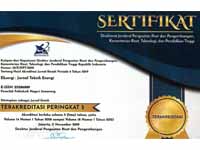STUDI ANALISIS SISTEM FISIK THERMAL DENGAN PEMODELAN STIRRED TANK HEATER MENGGUNAKAN SIMULINK MATLAB
DOI:
https://doi.org/10.32497/eksergi.v17i1.2282Keywords:
Stirred Tank Heater, Sistem fisik thermal, Simulink, MatlabAbstract
System thermal dengan model Stirrer Tank Heater diturunkan secara matematik dan memodelkan di dalam Simulink Matlab. Hasil akan dianalisis dan dibandingkan antara system yang menggunakan gangguan dan system yang tidak ada gangguannya. Dengan demikian transfer function untuk perubahan laju kalor input dengan temperature output adalah R/RCs, sedangkan untuk temperature cairan aliran masuk berfluktuasi adalah 1/RCs dan berfunsi sebagai gangguan (disturbance). Sistem thermal stirrer tank heater tanpa gangguan dengan sisi aliran masukan ditutup setelah penuh dan sisi output tidak bervariasi memberikan analisi performance yang lebih baik dengan data 1,56References
. Ogata, K. Laksono E., Teknik Kontrol Automatik (Sistem Pengaturan), Penerbit Erlangga.
. Surindra, MD, Widyaningsih, WP, Margana, Supriyo, Mulud, TH. Sistem Kontrol Proportional Integral Derivative (PID) Untuk Mengatur Kecepatan Motor DC Menggunakan Mikrokontroller, Prosiding Seminar Nasional NCIET, Vol.1 (2020), B528-B534.
. Surindra M.D. (2013). Analisis Respon Output Dari Pemodelan Kontrol Proporsional Pada Aktuator Motor DC, Eksergi, Vol. 9 No. 2 Mei 2013, 43 ”“ 46.
. The expert team at Hot Disk”™s head office, located at the Johanneberg Science Park on the Chalmers University of Technology campus in Gothenburg, Sweden, https://www.hotdiskinstruments.com/applications/measurement-accuracy-and-thermal-conductivity-of-water/
Downloads
Published
Issue
Section
License
Authors who publish with this journal agree to the following terms:Authors retain copyright and grant the journal right of first publication with the work simultaneously licensed under a Creative Commons Attribution License that allows others to share the work with an acknowledgement of the work's authorship and initial publication in this journal.
Authors are able to enter into separate, additional contractual arrangements for the non-exclusive distribution of the journal's published version of the work (e.g., post it to an institutional repository or publish it in a book), with an acknowledgement of its initial publication in this journal.
Authors are permitted and encouraged to post their work online (e.g., in institutional repositories or on their website) prior to and during the submission process, as it can lead to productive exchanges, as well as earlier and greater citation of published work (See The Effect of Open Access).






